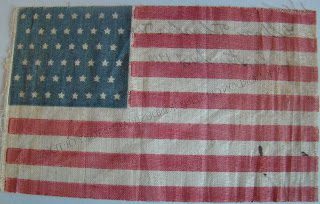Tying Us Together: A Thurber Friendship Quilt

By special guest blogger Bethany Kolter Dodson
Texas has a long-practiced tradition of quilt making. Young girls routinely learned the skill because patchwork became a common style of bedding during the westward expansion. Patchwork provided a colorful and practical way to use old clothing and small scraps of material both artfully and economically in a time when practicality was the rule.
In the 1800s, women began forming quilting groups, turning work into a social and communal activity. Album quilts, along with other variations known as signature and friendship quilts which included embroidered autographs, served as family trees or town records to mark events like weddings or deaths. They evolved into keepsakes given to pastors, friends, or family members who were about to move away. While the common sentiment was one of remembrance, the quilts themselves varied stylistically. There was no one specific pattern. Any design with room for an embroidered autograph, such as Nine Patch, Star, Mariner’s Compass, Chimney Sweep, and Snowflake, was used. An abundant number of patterns bear the name Album or Friendship.
From the 1920s onward, flour, sugar, salt, grains, seeds, and feed were sold in large, cotton muslin bags. Considering the frugality needed to survive during the Depression, it is not surprising that women cleverly used the sack material to create dresses, quilts, and many other household textiles. Soon grain dealers caught on to this growing trend and began selling bags made of printed cottons to encourage brand loyalty. Patterns of all kinds emerged in every color imaginable. It took three to four one hundred-pound sacks to make a dress, so women carefully bought and traded brands to get the matching prints they wanted. As a result, women gained power in the marketplace by exerting substantial influence over the brands of foodstuffs and animal feed purchased by their family members. Leftover scraps were perfect for creating a distinctive square for a friendship quilt.

As aesthetically pleasing as these works of art are, the stories of community behind them gives them special significance. The quilts speak of the deep friendship and camaraderie that surrounded their creation. A collection of squares acquired by the Gordon Center in 2007 demonstrates how Thurber women participated in this tradition. Mrs. Etta Lane embroidered “Thurber, Tex.” and “January 30, 1932” along with her own signature on her square tying the work and herself to the community. Sarah Etta Lawson married Samuel Lane in Erath County, Texas, about 1899 when she was sixteen. The Lanes were long time residents of Thurber, where Sam worked at the brick yard. Sadly, Mr. Lane died from internal injuries as a result of a fall from a boxcar on May 2, 1932, only months after Etta dated her quilt square.

Almost all the names that appear in this collection of blocks were found in the 1930 census, along with other clues to their daily lives. Many lived with their families on the east side of town in the vicinity of the brick yard. The census highlights that Mrs. Etta Lane was a close neighbor to fellow quilter, Mrs. Louise “Lou” Kim. Some were homemakers, while others, like Ms. Sue Martin worked outside the home as a telephone operator.

The historic quilts of this style hold the stories and secrets of relationships past. While many of the people who created them are gone, the memories of good times, close friends, and tightly-knit communities that cared and leaned on each other are passed down for the present generation to remember and recognize. Today quilting guilds across America work to preserve the tradition and celebrate their own special experiences together by creating new friendship quilts to pass down




